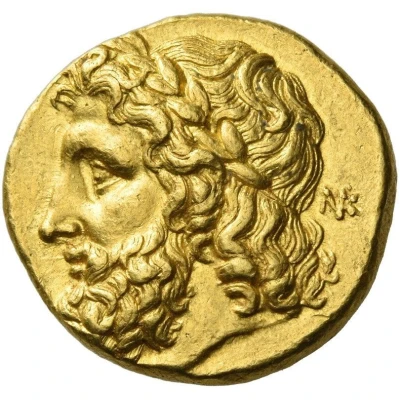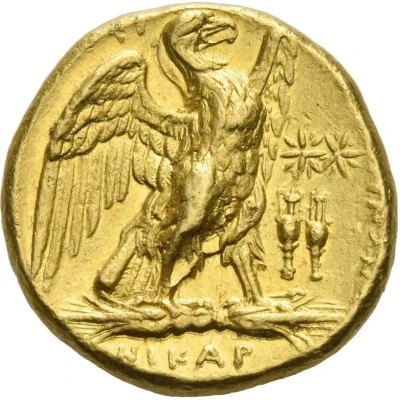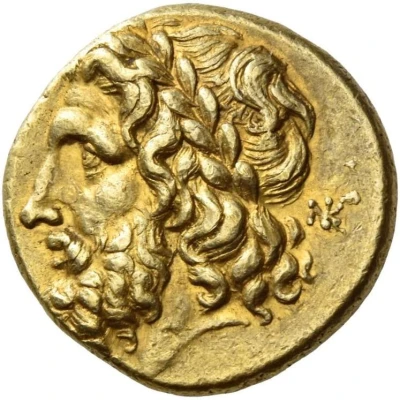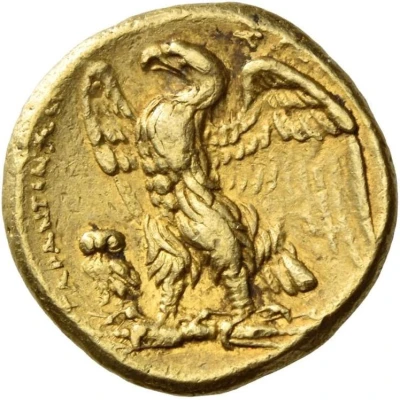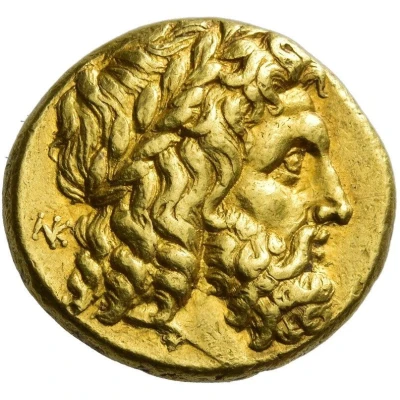
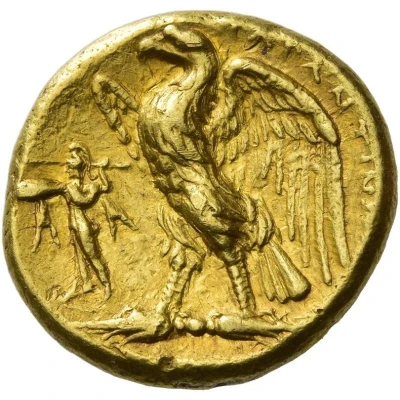

Stater 272 BC
272 BC year| Gold | 8.57 g | - |
| Issuer | Tarentum (Calabria) |
|---|---|
| Type | Standard circulation coin |
| Year | 272 BC |
| Value | Gold Stater (20) |
| Currency | Attic drachm |
| Composition | Gold |
| Weight | 8.57 g |
| Shape | Round (irregular) |
| Technique | Hammered |
| Demonetized | Yes |
| Updated | 2024-10-09 |
| Numista | N#387150 |
|---|---|
| Rarity index | 100% |
Reverse
Eagle standing left on thunderbolt, with spread wings; at its feet, Athena Alkidemos advancing left.
Script: Greek
Lettering: TARANTINΩ[N]
Comment
Fischer-Bossert G 39.
Only nine specimens are known.
This very rare gold stater dates to the time of King Pyrrhos of Epiros' involvement in Tarentine affairs in southern Italy. During the first decades of the third century B.C., Roman power had extended to most of Italy. Attempting to subdue the loose tribal confederation of Lucanians in the southwestern tip of the peninsula who had proven a nuisance to their ambitions, the Romans violated their preexisting treaty with Tarentum when they sent warships into the Tarentine Gulf to blockade the city of Thurium. The Tarentines responded in force, expelling the garrison which the Romans had installed at Thurium. Knowing that this would precipitate an unwanted war with Rome for which they were unprepared, the people of Tarentum called on Pyrrhos for assistance. At the time that this request from Tarentum came, Pyrrhos had just been evicted from his Macedonian possessions by King Lysimachus of Thrace. The previous decades had seen Pyrrhos largely as a pawn in the great games of the warring Diadochs, the successors of Alexander the Great, and their sons. While he had certainly proven to be a capable and dynamic general during these events, at the time Tarentum called on him, having recently lost his kingdom in Macedonia and reduced to only his possessions in Epiros (and that owing substantially to financial and material support from the Ptolemaic Kingdom in Egypt), the prospect of a western campaign offered Pyrrhos an outlet for his energies as well as a chance for expanding his domain and for earning greater glory. While Pyrrhos defeated the Romans decisively in three engagements, he had not counted on Roman tenacity. At this time the Romans controlled an incredibly vast territory and also had the support of a large network of allied states, all of which could provide more troops and material. Additionally, his gains were not without cost: in each engagement he lost large numbers of his most experienced officers, which indeed provides some insight into Roman military tactics. According to Plutarch, these losses caused him to quip "[if] we are victorious in one more battle with the Romans, we shall be utterly ruined" (Plutarch, Pyrrhus 21.9), which gives us the modern phrase Pyrrhic victory, meaning a success earned at such a heavy toll that any sense of achievement or profit is negated. The gold of Tarentum is all very rare today, but must have originally seen a very large output. In addition to staters, there are halves, thirds, quarters, eighths, tenths, twelfths, and sixteenths. Additionally, at this time the silver nomoi were reduced in weight from circa 7.9 g to circa 6.6 g, and were struck in prodigious quantities. This increased productivity simply illustrates the effect of war on a mint, especially of a city like Tarentum needed to hire mercenaries in order to wage war. The gold is often signed, as in the case here with the signature ÍÉÊÁÑ (other signatures that appear are ÓÙÊ and ÁÐÏË), and features the portraits of Zeus, Herakles, Apollo and Athena on the obverse, with either their respective animals (the eagle and the owl), representations of the eponymous founder of Tarentum, Taras, or, on this case, the figure of Athena Alkidemos (‘defender of the people’) probably a reference to Pyrrhos, on the reverse.
Interesting fact
The Stater coin from Tarentum (Calabria) was minted during the reign of King Pyrrhus, who is depicted on the obverse side of the coin wearing a wreath and holding a scepter. The reverse side features the goddess Athena holding a spear and a shield, symbolizing the city's patronage and protection. This coin was used as a means of payment and trade throughout the ancient Greek world and is considered a rare and valuable collector's item today.
